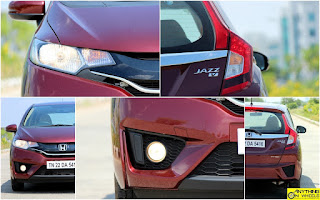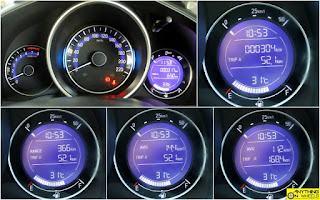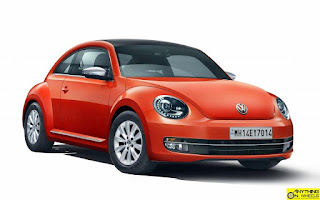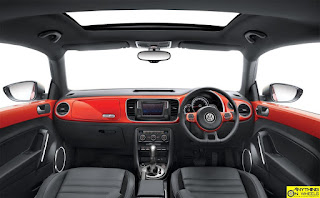Making a comeback in the Indian car market is next to impossible. Ask Fiat, if you’re in doubt! But, Honda did just that with the Jazz. When the car was originally launched in 2009, it was massacred by the Hyundai i20, its chief competitor. The absence of a diesel engine, lack of features and premium pricing meant the Jazz could hardly defend its position. In its second avatar now, all those shortcomings appear to have been addressed. The i-DTEC has joined the i-VTEC for duty under the hood, there are tons of features and the pricing isn’t insane as it was before. As a result, the Jazz is off to a good start.
Will the new Jazz overcome the odds and make it big in India this time around? We spent the better half of a day with the V petrol variant to find that out.
TO LOOK AT:
Internationally, the Jazz is in its third generation and all three iterations have followed the same ‘monobox’ design theme with just evolutionary updates differentiating each of them. This time though, those evolutionary updates are far more significant. The new Jazz resembles its predecessors, but also looks chic and contemporary.


Honda's new found obsession with thick chrome bars and complex fascias means simple and staid designs are a thing of the past. The new Jazz is no exception. It is sharp and aggressive like all new Hondas but isn't tacky like some of them. The car shares a lot of its frontal styling elements with the City but what earns more brownie points for the Jazz is the absence of the chrome bar in the grille. The piano black finish underlined by a thin chrome strip looks classy and exudes a premium feel. The short hood, steeply-raked windshield and the large glasshouse hint at the car’s practical nature that prioritizes function over form. Jazz’s wheelbase is longer than most of its competitors and the overhangs shorter. As a result, it transcends segments and does look like a MPV from several angles. We have seen people commenting that it looks like a mini Innova!

Just like the City, the new Jazz has cuts and creases all around. It appears as if Honda poached design engineers from arch rivals Hyundai and put them in charge of these newer models. Look at the silhouette to know what we mean. The prominent shoulder line that originates in the front door runs across the length of the car before merging with the taillight and changing course to go with the rear bumper. There is also this inverted swoosh just above the rocker panels. The rear lights are so Volvo-esque and look striking with those reflector extensions at the top. The good thing is, the taillights have LEDs inside and not just lenses that mimic their appearance. As is the norm these days, there is a chrome bar running across the boot that also acts as the number plate garnish.


Honda has tried its best to reduce Jazz’s visual bulk by incorporating plastic inserts in the rear bumper and a roof spoiler but the car still looks bulbous from the rear. From the rear three-quarters, it appears under tired too. Indians love fuel efficiency and Honda has rightly skimped on tire specs for better efficiency. They can’t be blamed for that, can they?
The V variant we drove misses out on the bigger and sporty rear spoiler that ups the style quotient significantly. But, the rich ‘Carnelian Red’ shade, one of the two pearl finishes on offer apart from Orchid White, more than made up for the lost glamour.
TO SIT IN:
Jazz’s cabin belie its external dimensions and it dawns on you the moment you get close to the car. The doors open wide, ingress and egress are straightforward and adult-friendly and the space inside is truly incredible for a car that measures less than four meters in length. All this packaging brilliance results in a cabin that's spacious enough to accommodate five well-built adults comfortably. This is one hatch that could put a lot of sedans to shame in that aspect. Having said that, the comfort levels offered by the rear bench is just about average. The front seats fare much better and offer better lateral as well as under-thigh support.

Step in and it’s hard to mistake this cabin for anything but a Honda. The steering wheel, the instrument binnacle, the center console and, in fact, the whole dashboard is similar to Honda’s best-selling sedan sans a few niceties here and there. The instrument cluster, for instance, does not have the attractive ECO rings that illuminate blue or green depending on our driving style, the multi-functional steering wheel loses the cruise control switches and the dashboard has an odd plastic cap in place of the nice Start/Stop button. Crucially, several features from the City are retained as well. The MFD (Multi-Functional Display) is comprehensive and has twin trip meters, average and instantaneous fuel efficiency indicators as well as a Distance To Empty readout. The intuitive touchscreen climate control system that responds nicely to the touch with a firm beep is a popular show-off feature in the City and is standard on all but the base variant of the Jazz too.



The asymmetric dashboard with uniquely-shaped air-conditioner vents is angled towards the driver with controls falling nicely in hand. The black dashboard with beige upholstery is an unique combination but it works in making the cabin feel bigger and airy. The glossy-black center console has a 5-inch display screen with USB, Aux and BlueTooth connectivity. Storage options are aplenty with the Jazz offering more than enough space, be it for keeping that expensive mobile phone of yours safe from prying eyes or stowing a drink you just grabbed without spilling on the move. Build quality, fit and finish are good but nowhere near the benchmark set by the Hyundai i20. We are sure the previous Jazz had better quality inside and out. But, Honda had to cut costs somewhere and its clear where they have done that!

The Jazz is a feature-rich car with the V variant that we drove coming with ABS, dual airbags, power mirrors, rear parking camera and steering-mounted audio controls apart from the features we covered elsewhere. But the incredibly useful ‘Magic Seats’ that was standard in the previous Jazz is now exclusive to the VX variant. We know people who stretched their budget and bought the base variant of the previous-generation Jazz just for this feature and Honda has done people like them no good with this strategy. Forget the Magic Seats, the top-but-one V trim level doesn’t even get adjustable headrests at the back! Can you imagine this in a premium hatchback that costs 8 Lakhs on road?
Ironically, the V trim level betters the top-end VX in some aspects. The USB and Aux inputs in VX are crudely routed through the glove box while the V gets them neatly integrated in the dashboard. The parking camera in the VX offers just a single view in the touchscreen-equipped VX while the V gets three views including an useful wide-angle option. The fact is the product planning team at Honda India have got this wrong. The V trim level should have got the Magic Seats and the VX shouldn't have been left wanting. What were they thinking?
ON THE ROAD:
The new Jazz's party trick against its big-selling rivals is the 1.5-liter 'Earth Dreams' i-DTEC engine that's not just the most powerful in the class but also amongst the most fuel-efficient. But the car we drove had the 1.2-liter i-VTEC petrol engine under its not-so-big hood. The engine, that also powers the Brio and Amaze in Honda's Indian lineup, generates 89 horsepower at 6000 rpm and 110 Nm of torque at 4800 rpm. While the bigger 1.5-liter mill from the City would have made the Jazz a hoot to punt around town, the smaller and less powerful 1.2-liter unit is all we have right now.

Turn the ignition on and the Jazz impresses with superb refinement levels. The i-VTEC is a smooth gem and stays that way as you pass through the low revs. Though the engine gets quite audible at high revs, it is nowhere intrusive or disturbing. Get going and the i-VTEC's weak bottom end raises its ugly head. Up until 2000 rpm, the response is weak and the car feels lethargic. From there, things get progressively better. An acceptable mid-range and a strong high-end try to make up for crucial time lost flogging the engine at low revs. Like other i-VTECs, Jazz's mill is rev happy and shoots cleanly up to its marked 6500 rpm redline, making rapid progress while doing so. The clutch is light and gearshifts are smooth and precise with narrow well-defined gates.

The current crop of Hondas roll out of the factory tuned for comfort over corner-craving capabilities and the Jazz continues that tradition. Handling is safe and predictable all the way upto 130 km/h (That's the highest we achieved all day!) and the Jazz doesn't throw nasty surprises on the move. But this isn't a car that will leave you smiling at the end of a long drive. Blame it on the Jazz's steering which is too light. Sure, it does weight up as speeds build up but that's still not reassuring enough. The i20 need not fret! If fun-to-drive factos is what you need, the Swift is still the better choice. Ride quality is good at all speeds with the Jazz ironing out small and medium-sized bumps and potholes with ease. Larger craters still filter into the cabin with strong thuds.

Gone are the days when premium hatchbacks offered all disc brakes. The Jazz, like its competitors, offer the standard front discs and rear drums. Braking is good and the Jazz sheds speed and comes to a stop without losing its composure. The tires could have offered more grip though and gives up much before the car does.
SPECIFICATIONS:
| Engine Type: SOHC i-VTEC |
| No of Cylinders: 4 |
| Displacement: 1199 cc |
| Maximum Power: 89 bhp @ 6000 rpm |
| Maximum Torque: 110 Nm @ 4800 rpm |
| Transmission Type: 5-Speed Manual |
| Tires: 175/65 R15 |
| Brakes: Disc (Front), Drum (Rear) |
WE VOTE FOR:
* Incredibly spacious cabin and boot
* Edgy and sharp styling
* Long feature list
* Multiple engine and transmission options
WE VOTE AGAINST:
* Weak low end performance
* Quality levels a notch below previous-gen Hondas
* Presence of Magic Seats only in the VX trim
* Priced at a premium vis-a-vis rivals
VERDICT:
Indians are unforgiving and the fact that the new Jazz is off to a good start in our market speaks volumes about the car's strenghts. Honda has worked to iron out most of the flaws of the previous model while continuing to improve on its strengths. Sure, it does have its own set of flaws - the quality levels are falling, it misses some important features and the petrol engine has a lousy bottom end. Look beyond them though and the Jazz comes across as a stylish and spacious hatchback that offers tons of features and acres of space to keep its occupants happy. Moreover, the strong brand pull enjoyed by Honda and the multiple engine and transmission options (1.2-liter petrol manual, 1.2-liter CVT petrol and 1.5-liter diesel) on sale makes the Jazz a complate package.
If they aren't already, Maruti-Suzuki and Hyundai should be watching over their shoulders now. Well done, Honda!
Photography: Venkat Narasimhan | Editing & Text: Aravind Ramesh





















